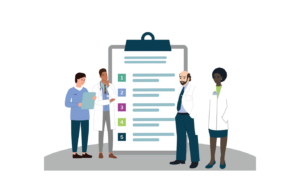Unlock Cost-Saving Secrets: 5 Ways Healthcare Practices Boost Productivity
By Blakely Roth | January 4, 2024
The challenges of staffing shortages and rising administrative costs are becoming increasingly prevalent. As a specialty healthcare practice leader, finding ways to maximize productivity without adding to your administrative headcount or increasing payroll can seem like a daunting task. With the right strategies and automated solutions—that actually do what they promise to—you can overcome these hurdles and streamline your operations. In this article, we will explore five ways to increase productivity in your healthcare practice while keeping costs under control.
The Current Landscape: Staffing Shortages & Rising Costs
Reports show that staffing shortages continue to plague healthcare practices, particularly in front office and operational roles. In fact, turnover rates in these positions are at an alarming 30%, which is higher than any other category in healthcare careers. Simultaneously, labor costs have been on the rise, with an average increase of 10% nationally while benefits costs are up 56%, according to the American Medical Group Association,
But hey, it’s not all doom and gloom! In sharp contrast to the troubling staff shortage data, nearly half of today’s providers have been able to offset these shortages thanks to technological improvements. It’s clear – embracing tech could be your game-changer!
Let’s explore actionable steps you can take to increase productivity without increasing staffing overhead.
1. Delegate Human-Related Tasks
To make the most of your administrative staff’s time and expertise, it is essential to delegate tasks that don’t truly require a human touch. Identify areas where automation or self-service options can take over, freeing up valuable resources.
For instance, implementing self-check-in kiosks allows patients to input their information directly into the system, decreasing the need for manual data entry by staff members. This self-service solution not only saves time but also reduces errors associated with manual data entry or illegible handwriting. Automation will provide you with a way to reduce FTE costs while increasing collections, data accuracy and reducing billing errors, further helping your practice patch profit leakage challenges.
Been burned by automated solutions before, or hesitant to switch complex tasks to digital solutions?
It’s not uncommon for practice leaders and physicians to be conservative with how they delegate manual tasks to automated healthcare solutions. Yet, with rising costs and evolving solutions, high-growth practices can’t afford to fill gaps by adding more headcount (and payroll). They also can’t afford the costly setbacks of poor data that can result from human error…
Executive Director of Strategy for the Mayo Clinic shares, “Thirty percent of healthcare has the potential for automation, so we really want to reduce administrative burden, reduce manual tasks and processes in order to free up our most valuable asset, which is our people, and make sure they’re doing human-related tasks versus things that could be potentially automated.”
The key to unlocking the success of automation is to find a solution that is purpose-built to streamline patient registration, scheduling, communications, payments and eligibility verification. See what that means for your practice and why you may need to go beyond the add-on services offered by your practice management system (PMS) or electronic health record (EHR).
Steps 2-5 discuss where you can embrace technology, meet provider and patient expectations, reduce staffing redundancies and boost practice efficiency‚ while putting more money back in your practice.
2. Embrace Technology Automation
Technological advancements have revolutionized the healthcare industry, offering numerous opportunities for increased productivity. Embracing automation in various aspects of your practice can lead to significant improvements.

Reduce time-consuming staff tasks around scheduling, clinical intake, registration, eligibility verification, communications and payment collection — by automating them. By automating these critical patient touchpoints you can reduce front-end staff work and reallocate or reduce the number of full-time employees (FTE) you need to run successful operations.
Take scheduling for example, managing the schedule is becoming a significant challenge for most practices due to the never-ending staffing shortage. Healthcare practices just don’t have the people-power at the front desk to manage the volume of phone calls coming in, which results in long hold times for patients, dips in acquisition and slow scheduling processes. Additionally, when practices rely solely on phone scheduling, they lack the real-time visibility to fill appointment gaps with last-minute and same-day appointments – creating lag times between when patients want to see a provider and when they can actually get into the office.
You can boost patient acquisition and reduce phone traffic for your staff at the same time by automating that process. While it may seem like scheduling should remain a human-related task, steps 3 and 4 cover how high-growth practices are making the switch and boosting patients and profits as a result.
3. Eliminate Redundancy and Inaccuracy
One of the primary sources of inefficiency in many practices is redundant tasks and inaccuracies caused by manual processes or automated solutions that don’t perform as expected.
Administrative errors account for 86% of mistakes in the healthcare industry, going further, practices can spend hours manually verifying insurance eligibility for each patient. Combining those errors and time spent, human intervention in patient benefits verification should be kept to a minimum.
Even with automated solutions in place, practices still find “eligibility expired” to rank among the top five reasons for medical claim denials, likely due to stale data and increased staff intervention when the automation falls short. Although many denials are corrected and eventually paid, research from Modern Healthcare estimates it costs an average of $118 per claim to recoup those funds. Implementing a solution that can truly reduce staff intervention and time spent on insurance verification is key to not only reducing staff workloads but also increasing collections.
The same argument for accuracy extends beyond eligibility verification. Going back to the scheduling example, by offering real-time, 24/7 online scheduling your practice can book more patients with less work and in a way that simply can’t deviate from your pre-determined scheduling requirements, since it’s all automated. Unlike traditional methods, digital solutions operate on autopilot, reducing errors in patient bookings and improving overall accuracy.
4. Tailor Your Workflows
Each healthcare practice operates differently, and what works for one may not work for another, which is another key reason that off-the-shelf automated solutions, like those offered by PMS/EHR won’t provide what you need to truly reduce staff burdens.
When seeking technology to automate mundane healthcare tasks, it’s crucial to find solutions that can be tailored to your specific workflows, practice requirements and provider expectations. Find a patient revenue platform™ that can be tailored to fit seamlessly into your registration, collections, scheduling and other operations to increase efficiency and reduce the burden on your administrative staff.
The flexibility of smart patient scheduling software is crucial for specialty practices with unique scheduling needs. For example, you might benefit from an automated scheduling system that allows you to optimize appointment slots based on your practice’s unique needs, leaving openings for providers who accept walk-ins.
Regardless of the number of physicians or unique practice specifications, a smart scheduling system can be adapted to fulfill the diverse requirements of healthcare practices and physicians. For example, The Orthopaedic Group implemented online scheduling, resulting in an increase in new patients every month and no complaints from their 26 on-staff providers. Lott says, “The online scheduler has been huge in helping book patients in the way that meets provider requirements, and now it is really on autopilot for us. It has been so seamless and improved our scheduling efficiency.”
A smart digital system will integrate into diverse workflows, catering to the specific requirements of each healthcare specialty, by removing questions, offering consents, capturing custom questions and more — all to help your practice work smarter, not harder.
5. Promote Patient Usage of Self-Service
As patients increasingly embrace self-service registration and scheduling tools, the need for labor-intensive manual data entry, lengthy payment discussions, booking management and in-person payment collection by healthcare staff significantly decreases. This transformative shift towards patient empowerment not only streamlines administrative processes but also alleviates the workload for healthcare professionals, enabling them to dedicate more time and attention to delivering exceptional quality care and fostering meaningful patient-provider relationships. How can you ensure patient adoption of self-service scheduling and registration solutions? Make their presence known and easily available to your patients.
A few examples:
- Place kiosks right in the front entry so patients can easily spot them upon walking in
- Add signs and banners to your lobby encouraging patient use, (i.e., “Check-in Faster at the Kiosk!”)
- Send flyers or emails that promote self-service registration and scheduling
- Utilize social media and emails to inform patients about online scheduling options, providing links and instructions for how to access them
- Update your website so “Book Now” buttons are easy to spot and use
- Make your self-service solutions user-friendly
Ready to Work Smarter, For Less!
As a specialty healthcare practice manager, navigating staffing shortages and rising administrative costs will continue to be challenging. By implementing the strategies, you can increase productivity without increasing your administrative staff headcount or payroll. Through smart solutions, tailored automation, delegation of tasks and technology adoption, you can streamline your operations and focus on providing exceptional care to your patients. Dig deeper into how Clearwave can help you optimize staffing through truly self-service solutions. Schedule a demo here.




